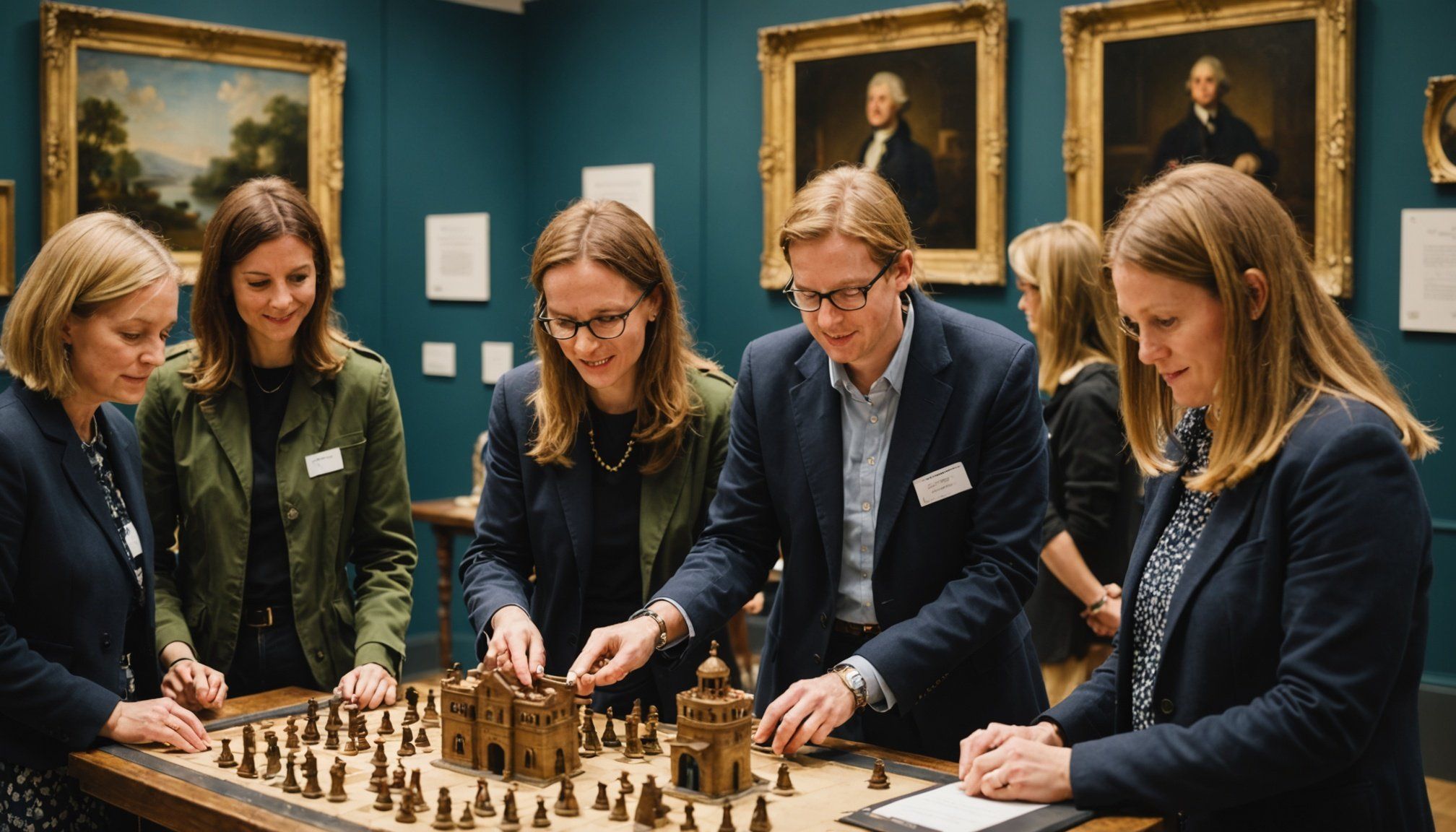Unlocking Visitor Engagement: 10 Innovative Strategies for UK Museums to Boost Growth and Discover New Opportunities
In the ever-evolving landscape of the museum sector, engaging visitors and fostering a deeper connection with the community has become a paramount goal. With the advent of cutting-edge technologies and innovative approaches, UK museums are poised to revolutionize the way they interact with their audiences. Here, we delve into 10 innovative strategies that are transforming visitor engagement and opening up new opportunities for growth.
Leveraging Virtual and Extended Reality
The integration of virtual reality (VR) and extended reality (XR) is one of the most exciting developments in the museum sector. A recent global survey conducted by the University of Glasgow’s Museums in the Metaverse (MiM) project revealed a strong public interest in using these technologies to access museum collections. Here are some key findings and implementations:
Have you seen this : Powerful Email Marketing Strategies for UK Small Businesses: Your Key to Thriving Success
- Public Interest: The survey found that 79% of respondents were interested in using digital technology to explore collections currently unavailable to the public. This indicates a clear appetite for immersive digital experiences[1].
- Case Study: The MiM project has developed an XR platform to showcase cultural heritage collections. For instance, a VR exhibition celebrating Lord Kelvin was unveiled, featuring objects not normally on public display within a digitally recreated 19th-century laboratory[1].
- Engaging Younger Audiences: VR and XR technologies have shown potential in attracting younger audiences. The Musée d’Orsay’s VR experience, “Tonight with the Impressionists, Paris 1874,” drew 18,000 visitors in just five months, primarily engaging 25 to 34-year-olds[1].
Augmented Reality Enhancements
Augmented Reality (AR) is another powerful tool that museums are leveraging to enhance visitor engagement.
- Interactive Storytelling: AR applications at historic sites like the Tower of London and museums such as the British Museum have transformed user interaction by integrating engaging storytelling features. These enhancements have led to a noticeable increase in visitor interest and satisfaction[3].
- Benefits for Visitors and Businesses: AR creates immersive environments by overlaying interactive information, making tourist experiences more memorable and fostering emotional and intellectual connections. For businesses, AR opens up increased revenue opportunities by encouraging longer visits and driving up spending on-site[3].
- Accessibility and Inclusivity: AR provides multilingual content and adjustable interfaces, accommodating visitors with varied needs and backgrounds. This broadens the potential audience and demonstrates social responsibility and inclusivity[3].
Innovative Digital Exhibitions
Museums are now incorporating a range of digital technologies to create interactive and immersive exhibitions.
- Interactive Learning: The Science and Industry Museum’s “Operation Ouch Food, Poo and You” exhibition is a prime example. This exhibit uses physical play, hands-on games, and interactives to engage visitors, particularly families, in a fun and educational way[2].
- Generative AI: The Metropolitan Museum of Art’s new immersive children’s space features open-ended digital interactive experiences using generative AI. This allows visitors to create their own digital souvenirs, such as sea creatures, enhancing their engagement and learning outcomes[2].
- Personalized Digital Companions: The Wonders of Medicine exhibition in the Novartis Pavilion uses a personalized digital companion to guide visitors through the space, creating a holistic and interactive experience that simplifies complex scientific content[2].
Harnessing the Power of Podcasts
Podcasts are emerging as a novel way to engage with museum audiences.
- Accessibility and Engagement: Podcasts offer an accessible way for visitors to engage with museum content outside the physical museum space. Many cultural institutions are adopting this trend, reshaping how they communicate with their audiences[5].
- Case Study: Museums in Scotland are using podcasts to provide in-depth stories about their collections and exhibitions. This approach not only enhances visitor engagement but also reaches a broader audience, including those who may not be able to visit the museum in person[5].
Community-Centric Initiatives
Engaging with local communities is crucial for the long-term success of museums.
- Collaborative Projects: The Galt Museum in Lethbridge, Canada, collaborated with the Blackfoot community to create an immersive project using photogrammetry, VR, 3D animation, and spatial audio. This project brought Blackfoot voices to the forefront, providing a unique perspective on historical events[2].
- Local Outreach: Museums in Scotland, such as the Highland Folk Museum, are engaging with local communities through various outreach programs. These initiatives help in building a stronger connection between the museum and the community, fostering a sense of ownership and engagement.
Funding and Support
Securing funding is essential for implementing innovative strategies in museums.
- National Lottery Heritage Fund: The National Lottery Heritage Fund has been instrumental in supporting various museum projects across the UK. For example, the fund has supported the digitization of collections and the development of interactive exhibits, enhancing visitor engagement and accessibility.
- Art Fund: The Art Fund has also played a significant role in supporting museums through grants and partnerships. Their initiatives, such as the Bloomberg Connects app, help museums showcase their digital collections and reach new audiences[2].
Social Media and Digital Marketing
Social media and digital marketing are vital tools for museums to engage with their audiences.
- Engagement Strategies: Museums are using social media platforms to share engaging content, such as behind-the-scenes stories, sneak peeks of new exhibits, and interactive quizzes. This helps in building a community around the museum and increasing visitor engagement.
- Case Study: The National Museums of Scotland have seen significant engagement on their social media channels by sharing interactive content and collaborating with influencers. This approach has helped in attracting a younger audience and increasing overall visitor numbers.
Museum Management and Leadership
Effective museum management is crucial for the successful implementation of innovative strategies.
- Leadership Vision: Strong leadership with a clear vision for innovation is essential. Murray Pittock, pro-vice principal of special projects at the University of Glasgow, emphasized the importance of embracing digital technologies to chart a course for the future of museums[1].
- Collaboration and Partnerships: Museums are increasingly collaborating with other heritage organisations, technology companies, and community groups to leverage resources and expertise. These partnerships are key to developing cutting-edge AR applications and other innovative projects[3].
Collections Care and Digitization
The digitization of collections is a critical aspect of enhancing visitor engagement.
- Accessibility: Digitizing collections makes them more accessible to a broader audience. With an estimated 90% of collections held in storage globally, digitization is seen as a way to broaden public engagement and increase accessibility[1].
- Case Study: The Natural History Museum of Los Angeles County (NHMLAC) has digitized its fossil collections, allowing visitors to explore fossils from their own backyards through a map-based digital interactive exhibit. This approach creates a personal connection between visitors and the museum collections[2].
Learning and Education
Museums are evolving to become more than just repositories of artifacts; they are becoming centers of learning and education.
- Implicit and Explicit Learning: Museums are leveraging forward-thinking technology to offer both implicit and explicit learning opportunities. For example, the Metropolitan Museum of Art’s interactive exhibits use generative AI to create learning experiences that are both fun and educational[2].
- Community Engagement: Museums in Scotland are engaging with local schools and communities through educational programs. These programs help in fostering a love for learning and culture from an early age, ensuring a lifelong engagement with the museum.
Table: Comparative Analysis of Innovative Strategies
| Strategy | Description | Benefits | Examples |
|---|---|---|---|
| Virtual and Extended Reality | Using VR and XR to access museum collections | Immersive experiences, broader accessibility | MiM project, Musée d’Orsay’s VR experience |
| Augmented Reality | Integrating AR for interactive storytelling | Enhanced visitor engagement, increased revenue | Tower of London, British Museum |
| Innovative Digital Exhibitions | Using interactive technologies for exhibits | Engaging learning experiences, increased visitor satisfaction | Science and Industry Museum, Metropolitan Museum of Art |
| Podcasts | Using podcasts for storytelling and engagement | Accessibility, broader audience reach | Museums in Scotland |
| Community-Centric Initiatives | Collaborating with local communities | Stronger community connection, increased engagement | Galt Museum, Highland Folk Museum |
| Funding and Support | Securing funding from heritage funds and grants | Financial support for innovative projects | National Lottery Heritage Fund, Art Fund |
| Social Media and Digital Marketing | Using social media for engagement and marketing | Increased visitor engagement, broader audience reach | National Museums of Scotland |
| Museum Management and Leadership | Effective leadership and management for innovation | Successful implementation of innovative strategies | University of Glasgow, National Museums of Scotland |
| Collections Care and Digitization | Digitizing collections for broader accessibility | Increased accessibility, personal connection with collections | NHMLAC, MiM project |
| Learning and Education | Offering learning opportunities through technology | Fostering a love for learning and culture | Metropolitan Museum of Art, Museums in Scotland |
Practical Insights and Actionable Advice
For museums looking to implement these innovative strategies, here are some practical insights and actionable advice:
- Start Small: Begin with pilot projects to test the feasibility and impact of new technologies and approaches.
- Collaborate: Partner with other museums, technology companies, and community groups to leverage resources and expertise.
- Engage with Your Audience: Use social media and other channels to understand your audience’s needs and preferences.
- Secure Funding: Explore various funding options, including grants from heritage funds and partnerships with private organizations.
- Focus on Accessibility: Ensure that your initiatives are inclusive and accessible to a diverse range of visitors.
Quotes from Industry Experts
- “Our research reveals a clear appetite for immersive digital experiences, with people eager to interact with cultural artefacts in new and exciting ways.” – Murray Pittock, pro-vice principal of special projects at the University of Glasgow[1].
- “Our research here – conducted over several months and drawn from a diverse audience sample of thousands of cultural heritage enthusiasts – demonstrates a clear appetite for virtual access and engagement with collections.” – Fergus Bruce, report co-author and research associate in digital culture and heritage economy for MiM[1].
- “AR creates immersive environments by overlaying interactive information, making tourist experiences more memorable and fostering emotional and intellectual connections with the visited sites.” – Marketing Coffee Talk[3].
In conclusion, the future of museums in the UK is bright, with a plethora of innovative strategies available to boost visitor engagement and discover new opportunities. By embracing technologies like VR, AR, and AI, and by focusing on community-centric initiatives, museums can create a more inclusive, engaging, and educational experience for their visitors. As the museum sector continues to evolve, it is clear that innovation will be the key to unlocking a brighter, more engaging future.











